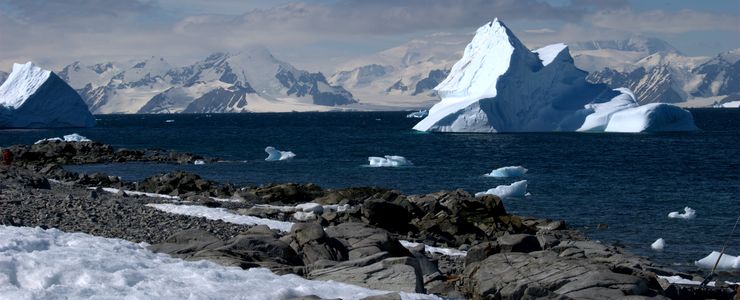Burning all fossil energy would eliminate all ice of Antarctica

Source: PIK Potsdam
The new calculations show that Antarctica’s long-term contribution to sea-level rise could likely be restricted to a few meters that could still be manageable, if global warming did not exceed 2 degrees. Crossing this threshold, however, would in the long run destabilize both West and East Antarctica – causing sea-level rise that would reshape coastal regions around the globe for millennia to come.
“If we were to burn all attainable fossil fuel resources, this would eliminate the Antarctic ice sheet and cause long-term global sea-level rise unprecedented in human history,” lead author Ricarda Winkelmann of the Potsdam Institute for Climate Impact Research says.
“This would not happen overnight, but the mind-boggling point is that our actions today are changing the face of planet Earth as we know it, and will continue to do so for tens of thousands of years to come. If we want to avoid Antarctica to become ice-free, we need to keep coal, gas and oil in the ground”.
The long-term risk increases with every additional tenth of a degree of warming
“By using more and more fossil energy, we increase the risk of triggering changes that we may not be able to stop or reverse in the future,” co-author Anders Levermann of the Potsdam Institute explains.
“The West Antarctic ice sheet may already have tipped into a state of unstoppable ice loss, whether as a result of human activity or not. But if we want to pass on cities like Tokyo, Hong Kong, Shanghai, Calcutta, Hamburg or New York as our future heritage, we need to avoid a tipping in East Antarctica,” he says.
“The idea was to compute what we have already started by emitting greenhouse-gas emissions from burning coal or oil – and to analyze where that will take us in the future,” says co-author Ken Caldeira of the Carnegie Institution for Science at Stanford University. Burning all available fossil-fuel resources would result in carbon emissions of about 10,000 billion tons.
Assuming a pulse of carbon release, the scientists’ simulations show that Antarctica would lose ice over at least the next ten thousand years in response, with an average contribution to sea-level rise of up to three meters per century during the first millennium. Consistent with recent observations and simulations, the scientists also found that even if global warming would be limited to two degrees, this already raises the risk of destabilizing the West Antarctic ice sheet.
“And the risk increases with every additional tenth of a degree of warming, with unabated carbon emissions threatening the Antarctic Ice Sheet in its entirety,” Ken Caldeira concludes.
“An ice cube in a warming room”
The comprehensive simulations take into account the impacts of atmospheric and ocean warming on the Antarctic ice as well as feedback mechanisms that might speed up ice discharge and melting processes. Moreover, they consider phenomena like enhanced snowfall due to global warming that might offset some part of the ice loss.
Even though major modeling challenges remain, like imperfect datasets of Antarctic bedrock topography, the simulations are particularly well suited for the long-term projections of the continental-scale evolution of the ice sheet. “It is much easier to predict that an ice cube in a warming room is going to melt eventually than it is to say precisely how quickly it will vanish,” Winkelmann says.
Currently, Antarctica contributes less than 10 percent to global sea-level rise and hence is a minor contributor compared to the thermal expansion of the warming oceans and to the influx from melting mountain glaciers. However, Greenland and especially Antarctica with their huge ice volumes are expected to be the major contributors to long-term future sea-level rise.
“Our results show that the currently attainable carbon resources are sufficient to eliminate the Antarctic ice sheet and that major coastal cities are threatened at much lower amounts of cumulative emissions,” Winkelmann says. “In a world beyond two degrees, long-term sea-level rise would likely be dominated by ice loss from Antarctica.”
Article: Winkelmann, R., Levermann, A., Ridgwell, K., Caldeira, K. (2015): Combustion of available fossil-fuel resources sufficient to eliminate the Antarctic Ice Sheet. Science Advances
Link to the article once it is published: http://advances.sciencemag.org/content/1/8/e1500589
Media contact:
PIK press office
Phone: +49 331 288 25 07
E-Mail: press@pik-potsdam.de
Twitter: @PIK_Climate
Media Contact
More Information:
http://www.pik-potsdam.deAll latest news from the category: Earth Sciences
Earth Sciences (also referred to as Geosciences), which deals with basic issues surrounding our planet, plays a vital role in the area of energy and raw materials supply.
Earth Sciences comprises subjects such as geology, geography, geological informatics, paleontology, mineralogy, petrography, crystallography, geophysics, geodesy, glaciology, cartography, photogrammetry, meteorology and seismology, early-warning systems, earthquake research and polar research.
Newest articles

Scientists transform blood into regenerative materials
… paving the way for personalized, blood-based, 3D-printed implants. Scientists have created a new ‘biocooperative’ material based on blood, which has shown to successfully repair bones, paving the way for…

A new experimental infection model in flies
…offers a fast and cost-effective way to test drugs. Researchers at the Germans Trias i Pujol Research Institute and Hospital have reinforced their leading role in infectious disease research by…

Material developed with novel stretching properties
KIT researchers produce metamaterial with different extension and compression properties than conventional materials. With this material, the working group headed by Professor Martin Wegener at KIT’s Institute of Applied Physics…



